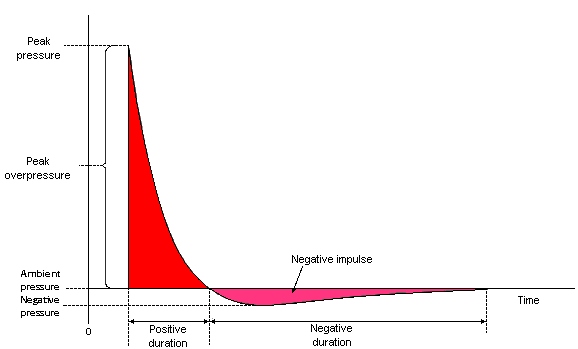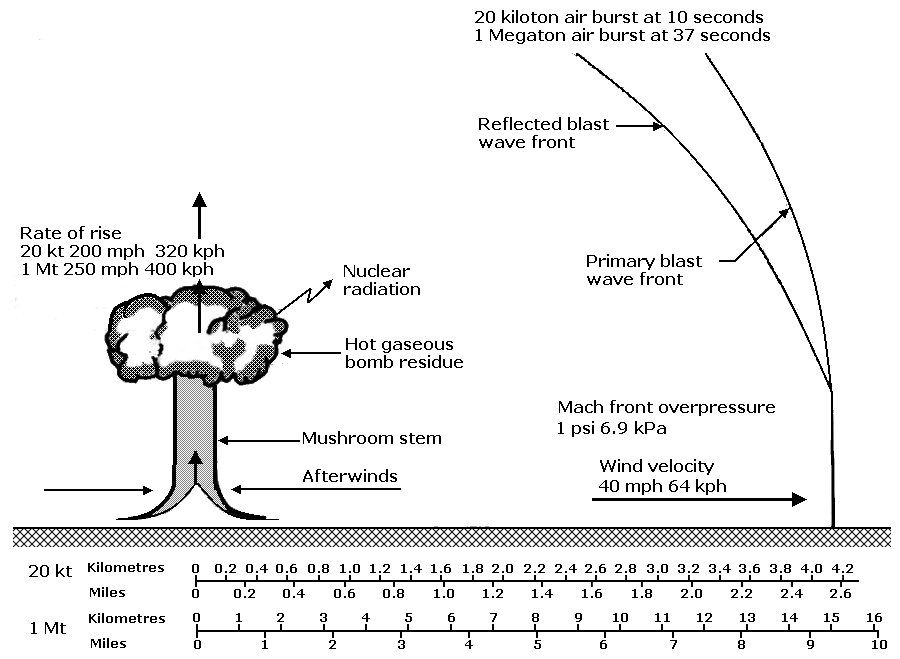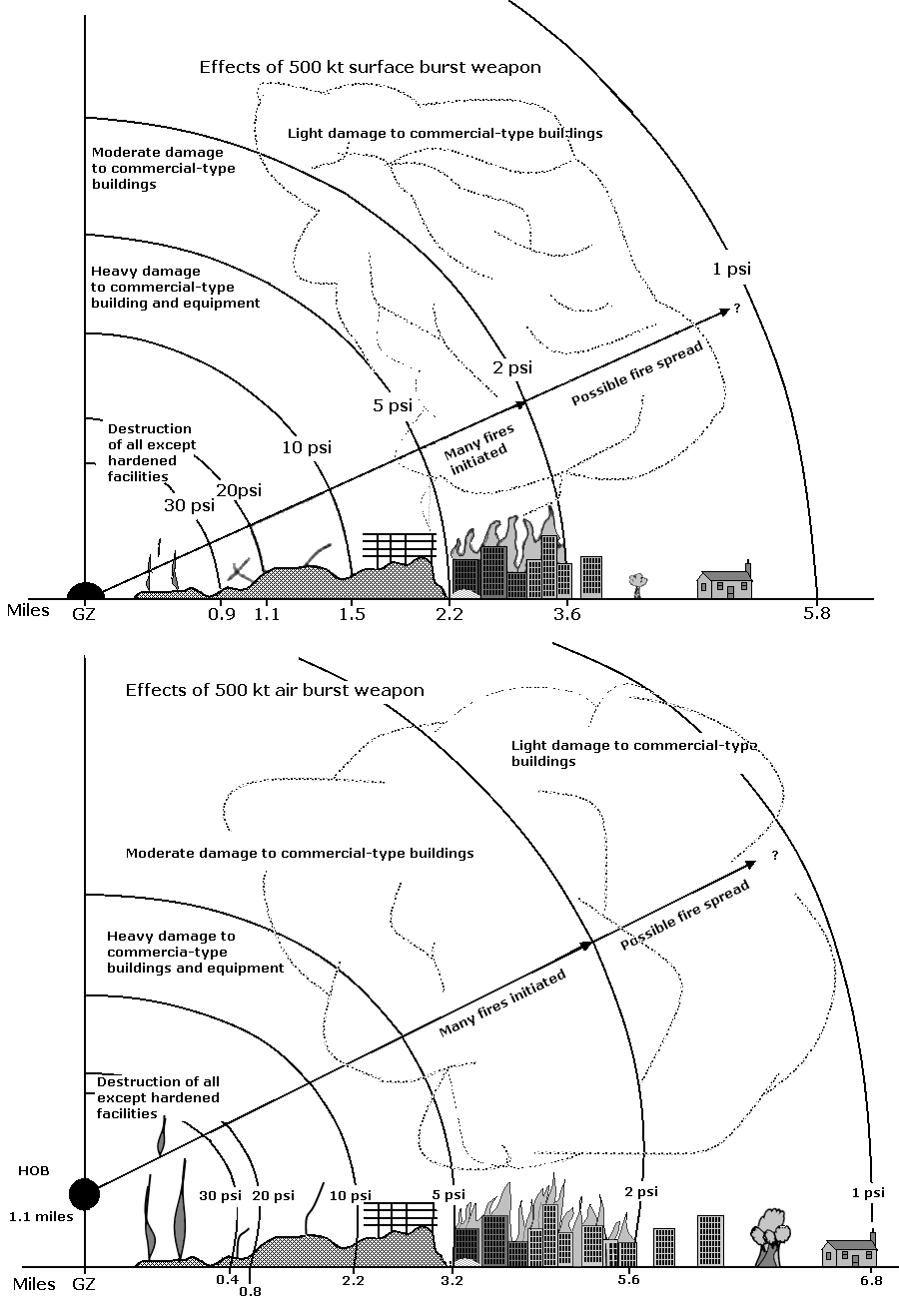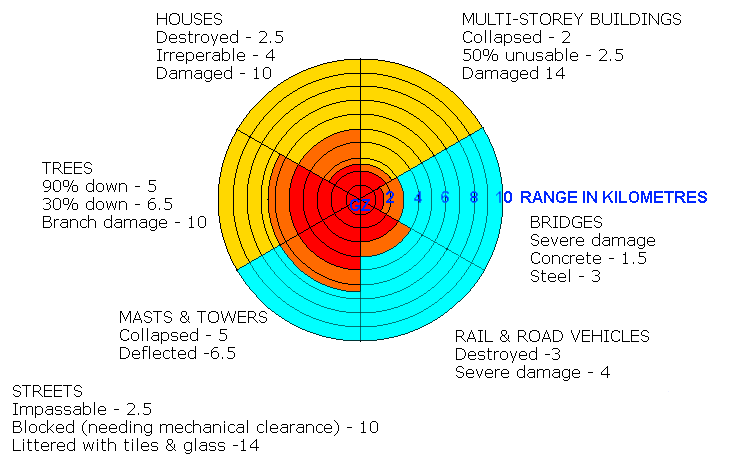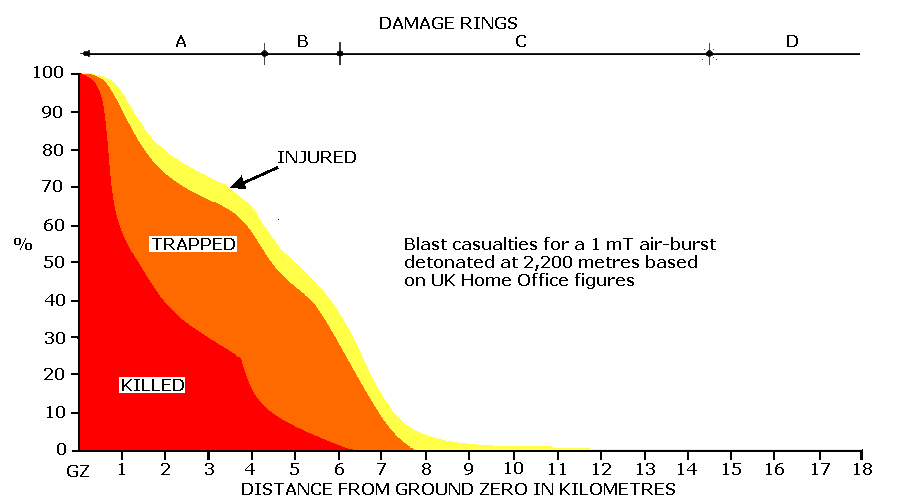Blast
Most damage to the urban environment, in a nuclear attack, would be due to blast. The rapid rise in temperature caused by a nuclear explosion creates a mass of gas at incredibly high pressure. It expands, creating a blast wave which may travel great distances causing damage. The range of blast damage depends on factors such as whether the explosion was ground burst or air burst, and on the . If the former it depends to some extent on the ground substrate, and the immediate surroundings. If air burst it depends upon the altitude.Blast wave
The front of the blast wave, the shock front, travels rapidly away from the fireball, behaving like a moving wall of highly compressed air. After the lapse of 10 seconds, when the fireball of a 1 MT nuclear weapon has attained its maximum size, about 1 mile across, the shock front is some 3 miles farther ahead. At 50 seconds after the explosion, when the fireball is no longer visible, the blast wave has traveled about 12 miles (19km). It is then moving at about 780 mph (1255 kph), which is slightly faster than the speed of sound at sea level (767 m.p.h or 1,235 km/h).
The damage resulting from the air blast of the shock wave may be brought about in two ways. First there is the sudden increase in pressure when the blast wave arrives. The pressure rises almost instantaneously to a value called the "peak overpressure" and then gradually falls off, during which a strong wind blows in the same direction as the front moves, and then becomes negative, the time taken for the pressure to return to normal atmospheric being longer at greater distances from the explosion, and for larger yield explosions. The peak overpressure is greater for larger explosions. Pressures are measured in units known as Pascals or for the pressures related to nuclear weapons effects in kilo Pascals. Standard atmospheric pressure is 101.325 kilopascal (kPa), typical car tyre pressures are in the range of 170 - 230 kPa. The unit previously used was the pound per square inch (psi).
The Royal Observer Corps was equipped with Bomb Power Indicators (BPIs) which recorded peak overpressures.
The distance at which a particular peak over-pressure is produced is proportional to the cube root of the weapon yield. The peak overpressure before it strikes anything is known as the incident peak overpressure. When it meets a surface it is reflected, the pressure wave produced is now known as the reflected peak overpressure. When this happens the peak pressure may be increased by a factor of from 2 to 8.
Drag damage is that which is caused by the reduction in pressure after the peak overpressure has passed, and pressure becomes negative relative to normal air pressure. Drag damage depends not only on the pressure but upon the length of time the pressure is applied. This duration also scales according to a cube root law so that for larger yields damage distances are greater than would be predicted by scaling pressure alone. The range of effects are increased for low air-burst weapons.
Mach effect
When the blast wave strikes the ground, or a surface of different density to air (e.g. the surface of the sea), it is reflected back, in a similar way to an echo. This reflected blast wave, like the original (or incident) wave, is also capable of causing material damage. At a certain region on the surface, the position of which depends mainly on the height of the burst and the energy of the explosion, the direct and reflected wave fronts merge. This merging phenomenon is called the "Mach effect." The "overpressure," i.e., the pressure in excess of the normal atmospheric value, at the front of the Mach wave is generally about twice as great as that at the direct blast wave front.For an air burst 1Mt weapon at an altitude of 6,500 feet (1981metres), the Mach effect will begin approximately 4.5 seconds after the explosion, in a rough circle with a radius of 1.3 miles (2.1 kilometres) from ground zero. The overpressure on the ground at the blast wave front at this time is about 20 psi so that the total air pressure is more than double the normal atmospheric pressure.
Mach front
Initially the height of the Mach front is small, but as the blast wave front continues to move outward, the height increases steadily. At the same time, however, the overpressure, like that in the original incident wave, decreases correspondingly because of the continuous loss of energy and the ever-increasing area of the advancing front. After about 40 seconds, when the Mach front from a 1Mt weapon is 10 miles from ground zero, the overpressure will have decreased to roughly 1 pound per square inch. The distance from ground zero at which the Mach effect commences varies with the height of burst. In the case of a very high altitude detonation there may be no detectable Mach effect.
Strong transient winds are associated with the passage of the shock and Mach front. These blast winds are very much stronger than the afterwind caused by the updraft caused by the rising fireball, which occurs at a later time. The blast winds may have peak velocities of several hundred miles an hour near to ground zero; even at more than 6 miles from the explosion of a 1Mt weapon, the peak velocity will be in excess of 10 miles per hour. Such strong winds obviously cause significant damage.
A difference in the air pressure acting on separate surfaces of a structure causes a resultant force on the structure. One of the most important characteristics is the overpressure, referred to above. The maximum value pressure at the blast (or shock) front, is called the "peak overpressure". Other characteristics of the blast wave, such as dynamic pressure, duration, and time of arrival are also of significance.
As the blast wave travels in the air away from its source, the overpressure at the front steadily decreases, and the pressure behind the front falls off in a regular manner. After a short time, when the shock front has traveled a certain distance from the fireball, the pressure behind the front drops below that of the surrounding atmosphere and a so-called "negative phase" of the blast wave forms. At some distance behind the shock front the overpressure has a negative value. In this region the air pressure is below that of the original (or ambient) atmosphere, so that an "underpressure" rather than an overpressure exists.
During the negative, rarefaction or suction phase, a partial vacuum occurs and the air is sucked in. instead of being pushed away from the explosion as it is when the overpressure is positive. At the end of the negative phase, which is somewhat longer, in duration, than the positive phase, the pressure has essentially returned to ambient. The peak values of the underpressure are relatively small compared with the peak positive overpressures; typically underpressure is not more than about 4 psi below the ambient, whereas the positive overpressure is typically much larger. With increasing distance from the explosion, both peak values decrease, the positive more rapidly than the negative, and they approach equality when the peak pressures have decayed to a very low level.
The
destructive effects of the blast wave are related to both the
values of the peak overpressure, and the dynamic pressure. For the
majority of building types, the degree of blast damage depends
largely on the drag force associated with the strong winds
accompanying the passage of the blast wave. The drag force is
influenced by mainly by the shape and size of the structure, but
this force also depends on the peak value of the dynamic pressure
and its duration.
The
dynamic pressure is proportional to the square of the wind
velocity and to the density of the air behind the shock front.
Both of these quantities may be related to the overpressure under
ideal conditions at the wave front.
Structural Damage
Most of the material damage caused by a ground burst, or low altitude air burst weapon is due directly or indirectly to the shock (or blast) wave which accompanies the explosion. Many structures will suffer some damage from air blast when the overpressure in the blast wave exceeds atmospheric pressure by about one-half pound per square inch. The distance to which this overpressure level will extend depends primarily on the yield of the weapon, and on the height of the burst.The degree and type of damage to a structure depends upon the power of a weapon, on whether it is air or ground burst. and upon the distance of the structure from the detonation. Additionally it depends upon a number of other factors which are features of the building under consideration such as the type and strength of the structure, its size, shape and orientation with respect to the explosion and upon the number of potential openings, e.g. doors, windows and wall panels which could fail during the passage of the blast wave. The damage is the result of displacement which can be caused by two major forces exerted by the blast. These are the abrupt rise in pressure as the shock wave hits the building, and passes over it in a fraction of a second, and the drag force which is exerted by the high wind throughout the duration of the positive pressure wave and tends to distort the building or to push it over on to its side.
When the front of a shock wave strikes a building it is reflected and the pressure on the face towards the explosion is momentarily increased by a factor of two or more. As the main shock front moves over and around the building, the pressure on that face falls again rapidly to the normal peak pressure in the shock front (i.e. before reflection occurred) and this same pressure is exerted side-on to the building. The shock front then is then diffracted, or bent, round the opposite end until the whole building is engulfed in the blast wave and the same pressure is exerted on all four walls and on the roof. Before the blast wave has completely surrounded the building there will be a considerable difference in the pressure on the sides facing towards and away from the explosion and, consequently a resultant force tends to move the building, as a whole entity, in the same direction as the blast wave. If the building has relatively few openings it will be subjected to this lateral "diffraction" loading for the time it takes for the shock front to pass from one end of the building to the other. The diffraction loading typically lasts for a few tenths of a second, but may be sufficient to cause considerable damage. Additionally if there are few openings such as doors and windows in the building, there may be insufficient time for the internal air pressure to rise to the same level as the external pressure, and the building will be subjected to crushing forces for as long as the positive pressure phase exists, in the case of large weapons this may be several seconds. In the case of more average buildings equalisation would occur more rapidly, and it may be that the internal pressure may rise above external pressure causing the building to explode outwards. This is because, typically, buildings are designed to withstand significant external pressure, but not internal pressure. tests have shown that typical British houses tend to fail in this way.
Wind drag loading
During the positive pressure wave, which may last several seconds, wind drag forces act on structures, mainly on those that are relatively small or of open structure, such as communications masts, telephone poles and girder bridges. This is because they permit rapid equalisation of pressure around them, and are not vulnerable to an all round external pressure.Ranges of damage
The range of blast damage is substantially greater for an airburst than for a ground-burst weapon. The exact magnitude of the increase depends upon the category of blast damage under consideration (it is greater for the less severe categories) and upon the exact height of burst. However, for most practical purposes it can be assumed that the radii of the various categories of damage for ground-burst bombs would be increased possibly by as much as 30 per cent, if the weapon were air-burst at about the optimum height.The various degrees of structural damage in built-up areas would in turn cause corresponding hindrance and obstruction to civil defence forces in vehicles and on foot. The next section describes the ranges of various categories of damage and street blockage for ground-burst weapons of different powers.
Damage Rings
Conventionally when calculating the zones affected by blast, circular rings are used, in the UK they are described as A, B, C and D. The reality is that this would only be true for a perfectly flat ground. The same is true of the effects zones for thermal radiation. In practice the shapes of hills and valleys would create shadows, significantly modifying the ranges of damage, in ways that would be difficult to predict. Nuclear tests have largely only been conducted over substantially flat areas, however Nagasaki is situated in a valley and therefore the damage zones were elongated. It is expected that slight damage to typical British houses would occur when the static overpressure shock front was about 0.75 p.s.i.; at 1 - 5 p.s.i. the houses would need repairs to remain habitable and they would be irreparably damaged at about 6 p.s.i. Slight damage would include the loss of roofing tiles, broken windows and the like. Irreparable damage means that houses would need to be demolished.
Blast casualties
Effects on the body
Blast injuries may be direct or indirect; the former are caused by the high air pressure and the latter by missiles and by displacement of the body itself. Fundamentally the blast injuries caused by nuclear bombs are similar to those caused by conventional weapons, but are significantly worse. This is due to the fact that the body is sensitive to the duration of the pressure pulse, and this is significantly greater for nuclear weapons except in the case of extremely small weapons (less than 1 kiloton). Indirect injuries resulting from nuclear detonations, in particular those caused by missiles, are similar in nature to those caused by HE weapons. However because of the longer duration of the pressure wave, injuries will occur at lower pressures.
Generally the way the body responds to blast is similar to small structures, because of the relative small size the pressure wave passes rapidly, however the body is subjected to sever compression forces. The forces decrease as the wave passes, at the same time the drag forces are considerable and cause a significant displacement risk.
Direct injuries (Primary)
Five parameters of the blast wave can affect the extent of the direct injuries to the body:- the ambient pressure,
- the effective peak overpressure,
- the rate of pressure rise (or "rise time") at the blast wave front,
- the character and "shape" of the pressure pulse,
- the duration of the positive phase of the blast wave and the associated wind.
The biologically effective peak overpressure depends on the orientation of the individual to the blast wave. If the subject is against a reflective surface, e.g., a wall, the effective overpressure for direct blast injury is equal to the maximum reflected overpressure, which may be a from two to about eight times the incident peak overpressure. In the open at a substantial distance from a reflecting surface, the effective overpressure is the sum of the peak incident overpressure and the associated peak dynamic pressure if the subject is perpendicular to the direction of travel of the blast wave and to the peak overpressure alone if the subject is parallel to this direction. For a given incident overpressure, the blast injury is expected to be greatest it the individual is close to a wall and least if he is at a distance from a reflecting surface and is oriented with his body parallel to the direction in which the blast wave is moving. Soft surfaces such as curtains have the effect of absorbing energy, but the amount of that absorption is difficult to predict as there are a considerable number of variables.
The body, like many other structures, responds to the difference between the external and internal pressures. As a consequence, the injury caused by a certain peak overpressure depends on the rate of increase of the pressure at the blast wave front. For wave fronts with a sufficiently slow pressure rise, the increase in internal pressure due to compression of the body and air ?ow into the lungs keeps pace (to some extent) with the external pressure. Consequently, quite high incident overpressures are tolerable if the rise time is sufficiently long. In contrast, if the rise time is short, the damaging effect of a given overpressure is greater. The increase in internal pressure of the body takes a definite time and the response is then to the maximum possible pressure differential. A sharply rising pressure wave will be more damaging than if the same peak overpressure is attained more slowly. If the blast pressure increases at first slowly and then quite rapidly; the injury potential of a given peak overpressure is decreased.
The body is able to survive surprisingly high pressures, up to 30 p.s.i. (206 kilopascals), although British houses are unlikely to survive above one fifth of that. The percentage of people who would survive such a high pressure is very small.
An individual inside a building but not too close to a wall would be subject to multiple reflections of the blast wave from the ceiling, floor, and walls as well as to the incident wave entering the structure. Since the re?ected waves would reach them at different times, the result would be a step loading, although the rise time for each step might be quite short. In such cases, where the initial blast pressure is tolerable and the subsequent pressure increase is not too great or occurs in stages, or slowly, a certain peak overpressure is much less hazardous than if it were applied in a single sharp pulse. The reason for the decreased blast injury potential in these situations is that the early stage of the pressure pulse produces an increase in the internal body pressure, which reduces the pressure differential associated with the later portion of the pulse. A higher peak overpressure is then required to cause a certain degree of blast injury.
A location against a wall is the most hazardous position because the effective peak overpressure, which is the maximum reflected overpressure, is high and is applied rapidly in a single step. A location a few feet from a wall can be expected to decrease the direct blast injury, although the hazard arising from displacement of the body will, in all probability, be increased. Oscillating pressures often exist inside structures due to reverberating reflections from the inside walls.
The duration of the positive phase of the blast wave is a significant factor for direct blast injuries. Up to a point, the increase in the duration in- creases the probability of injury for a given effective peak overpressure. Beyond this point, which may be of the order of several tens to a few hundred milliseconds, depending on the body size, it is only the magnitude of the overpressure that is important. The duration of the positive phase, for a given peak overpressure, varies with the yield and the height of burst of the weapon, but for most conditions, especially for powers in excess of about 10 kilotons, the duration of the positive phase of the blast wave is so long, approaching a second or more, that the effective peak overpressure is the main factor for determining the potential for direct injury from a fast-rising pressure pulse.
Death as a result of direct injury is likely to occur for pressures in the range of less than 50 psi to 100 psi with positive phase durations of the order of a second, for nuclear explosions. Ruptured eardrums may occur with peak overpressures of as low as 5 psi.
Casualties who survive for 24 to 48 hours in the absence of treatment, complications, and other injury usually recover and show little remaining lung hemorrhage after 7 to 10 days. In very severe injuries under treatment, recurring lung haemorrhage may occur as long as
5 to 10 days after injury. Experience from Hiroshima and Nagasaki is that those with severe blast injuries did not survive, but that those with less severe injuries recovered even without medical intervention
Brain injury due to air blast overpressure alone is improbable, indirect injury is far more likely, as a result of head trauma caused by missiles, debris, or displacement of the body.
Indirect blast injuries (Secondary, Tertiary & Quaternary)
Indirect blast injuries are associated with:
- the impact of missiles, either penetrating or non-penetrating (secondary effects),
- the physical displacement of the body as a whole (tertiary effects),
- exacerbation of existing conditions (quaternary effects)
The wounding potential of blast debris depends upon a number of factors; these include the impact velocity, the angle at which impact occurs, and the size, shape, density, mass, and nature of the moving objects. These are, of course, related to the total kinetic energy of the missile. Wounding potential is also affected by the part of the body involved in the missile impact. The associated risk is of a variety of injury types and severities, ranging from simple contusions and lacerations, at one extreme, through more serious penetrations and fractures, and critical damage to vital organs, at the other extreme.
The hazard from displacement depends mainly upon the time and distance over which acceleration and deceleration of the body occur. Injury is more likely to result during the latter phase when the body strikes a solid object, e.g., a wall or the ground. The velocity which has been attained before impact is then significant. This is determined by the physical parameters of the blast wave, as well as by the orientation of the body with respect to the direction of motion of the wave. The severity of the damage depends on the magnitude of the impact velocity, the area of the body that makes contact, and the nature of the surface or object struck. Likely injuries are contusions and fractures, and damage to vital organs, including rupture.
